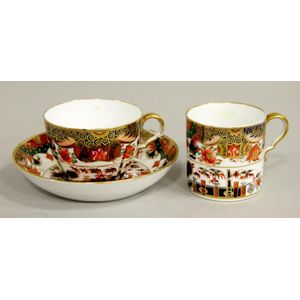English Porcelain Willow Pattern Trio with Gilding
An early 19th century English porcelain trio of tea bowl, saucer and coffee can with Willow Pattern and gilding. Unmarked, possibly Spode.
You must be a subscriber, and be logged in to view price and dealer details.
Subscribe Now to view actual auction price for this item
When you subscribe, you have the option of setting the currency in which to display prices to $Au, $US, $NZ or Stg.
This item has been sold, and the description, image and price are for reference purposes only.
- Gilding - Gilding is a method of ornamentation whereby a thin sheet of gold metal is applied to items made of wood, leather, ceramics, glass and silver for decorative purposes.
For furniture including mirrors, the sheet of gold is usually applied over a coating of gesso. Gesso is a mixture of plaster of Paris and gypsum mixed with water and then applied to the carved wooden frames of mirrors and picture frames as a base for applying the gold leaf. After numerous coats of gesso have been applied, allowed to dry and then sanded a coat of "bole", a usually red coloured mixture of clay and glue is brushed on and allowed to dry, after which the gold leaf is applied. Over time parts of the gilding will rub off so the base colour can be seen. In water gilding, this was generally a blue colour, while in oil gilding, the under layer was often yellow. In Victorian times, gilders frequently used red as a pigment beneath the gold leaf.
Metal was often gilded by a process known as fire gilding. Gold mixed with mercury was applied and heated, causing the mercury to evaporate, the long-term effect of which was to kill or disable the craftsman or woman from mercury poisoning. The pursuit of beauty has claimed many victims, not the least of which were the artists who made those pieces so highly sought after today. - Coffee Can - A coffee can is a cup for holding coffee, but of a cylindrical shape rather than the waisted shape of traditional cups. They were in use at the end of the 18th century and in the early 19th century.
- Willow Pattern - Although several potteries including Minton and Spode claim credit for design of the Willow pattern, the design is generally attributed to Thomas Turner of Caughley Porcelain Works in Shropshire, about 1780.
Whilst borrowing from the Chinese style, it was not a copy of a Chinese pattern.
The blue-and-white chinaware on which it appeared became immensely popular and the design was reproduced with variations by many English and European factories including Royal Worcester, Spode, Adams, Wedgwood, Davenport, Clews, Leeds and Swansea.
It was even copied in Asia, where it is still produced, with the wares being exported to Western countries.
The pattern portrays the garden of a rich mandarin whose young daughter elopes with his secretary. The lovers, overtaken on the bridge by her father, are transformed by the gods into birds and flutter beyond his reach. The scene with its willow tree usually covers the central part of a plate, dish, or bowl, with a border of butterflies, a fret, or other motif.
Traditional Willow pattern is in cobalt blue on white, though very occasionally other colours are used, such as purple or brown. The main part of the object contains the trees, houses, bridge, figures, and birds of the story and there is usually a fairly abstract pattern around the extremities.
This item has been included into following indexes:
- Copeland Spode (England), item types
- Copeland Spode (England), patterns - Willow pattern 33
Visually similar items

A late 18th century English porcelain trio of teacup, saucer and coffee can in Imari pattern, possibly Spode.
Sold by
in
for
You can display prices in $Au, $US, $NZ or Stg.

Two Chinese blue and white bowls, 20th century, together with an Imari plate, the bowl 25 cm diameter (3)
Sold by
in
for
You can display prices in $Au, $US, $NZ or Stg.

Antique Derby Imari cup and saucer c.1825
Sold by
in
for
You can display prices in $Au, $US, $NZ or Stg.

A Worcester apple green 'Spotted Fruit' pattern tea cup and saucer, circa 1770, faux Meissen crossed swords and numeral 9 marks
Sold by
in
for
You can display prices in $Au, $US, $NZ or Stg.
